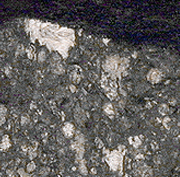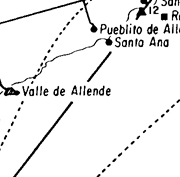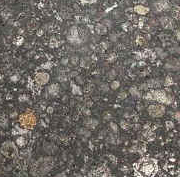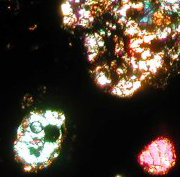Official Name:
Allende was given the name of the small village where most of the fragments fell.
Location:
Area surrounding the village of Pueblo de Allende, in the state of Chihuahua (northern Mexico).
Fall or Find:
Fall
Date:
February 8, 1969, 1:05 a.m. local time.
Mass Recovered:
More than 2 metric tons of the Allende meteorite have been recovered. It is the largest carbonaceous chondrite so far.
Number of Fragments:
Thousands of fragments reached the ground. The biggest fragment had a mass between 100 and 110 kilograms, but it fractured on impact with the ground.
Strewn field:
Allende's strewn field is one of the largest. Rocks were found in an area greater than 300 square kilometres. The major axis of the ellipse measures 48 kilometres.

Enlargement
Fragment of the Allende meteorite with partial fusion crust. |
|

Enlargement
The strewn field of the Allende meteorite covers more than 300 square kilometres. The fragments rained down on several villages. |
|
Crater:
Because the fragments were relatively small, no notable impact crater was created. Two fragments struck man-made constructions: a roof and a terrace.
Circumstances:
The rocks fell from the sky after the passage of a bluish-white fireball in the night sky. Residents of the village of Pueblo de Allende observed the astonishing luminous object travel from south to north. In an enormous explosion, the meteoroid burst into thousands of glowing pieces. Many villagers were jolted awake by the detonations associated with its passage through the atmosphere. Rocks came crashing down to the ground. Residents and collectors began to gather up the strange rocks right after the fall.
The meteoroid Allende weighed approximately 4 metric tons before it entered Earth's atmosphere, where it lost about half of its mass.
History:
1969 was a special year for the meteorite sciences. Within a period of a few months, rare carbonaceous meteorites fell from the sky, and moon rocks were brought back to Earth by the first astronauts to walk on the Moon. Anticipating the arrival of moon rocks, laboratories throughout the world had established analytic protocols. Pieces of the Allende meteorite were sent to them in order to test their techniques for analyzing extraterrestrial material.
Type:
Stony meteorite
Class:
Carbonaceous chondrite
Group:
CV3

Enlargement
Slice of the carbonaceous chondrite Allende. The chondrules are large and well defined. |
|

Enlargement
A chondrule and a calcium-aluminum inclusion seen in polarized light inside the meteorite Allende. |
|
Composition:
Allende is characterized by the presence of large, irregular white inclusions in a dark grey matrix. These are calcium-aluminum inclusions: the oldest known rock fragments in the entire solar system! The isotopic elements contained in these inclusions apparently come from the explosion of a supernova close to the original solar nebula.
The matrix is mainly composed of olivine. The total iron content is about 24%, but flakes of pure nickel-iron are rare. As their name indicates, carbonaceous chondrites contain carbon compounds, including amino acids.
Scientific contribution:
The Allende meteorite, a veritable gift from the sky, revolutionized meteorite science. After this fall, scientists had 2 metric tons of a rare type of meteorite. Allende and other carbonaceous chondrites provide clues about the evolution of our solar system. This is why they are so interesting to study.
Comments:
Fragments of the Allende meteorite are still being discovered today, so the total mass recovered increases slightly every year.
Part of the Planétarium's collection:
Yes